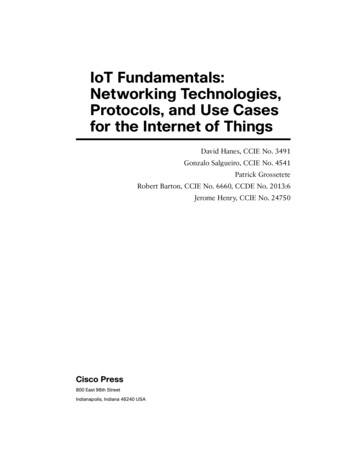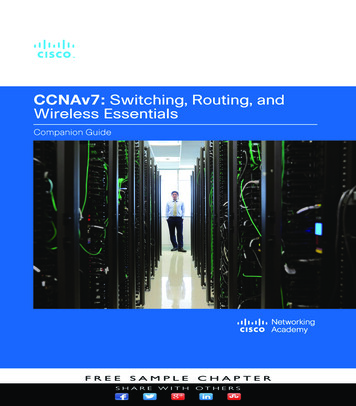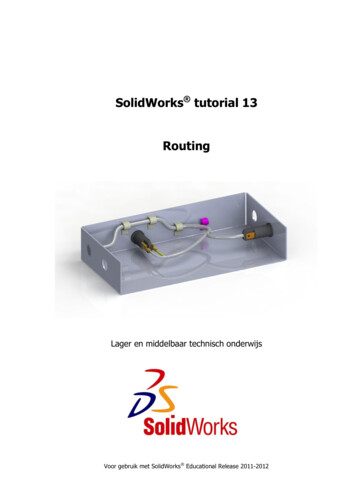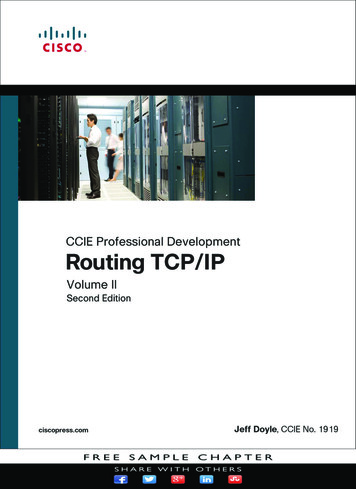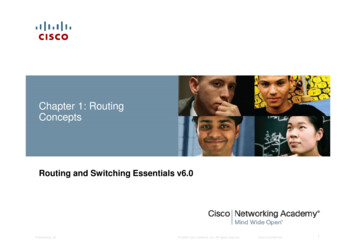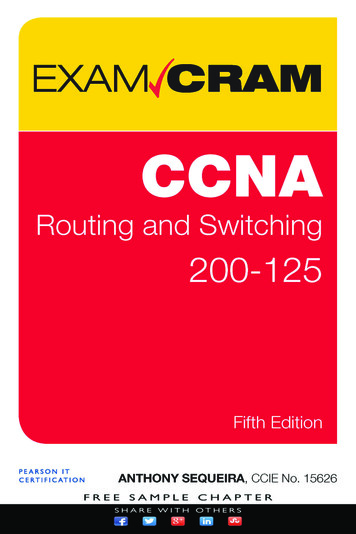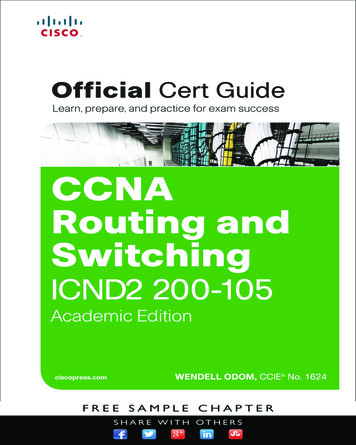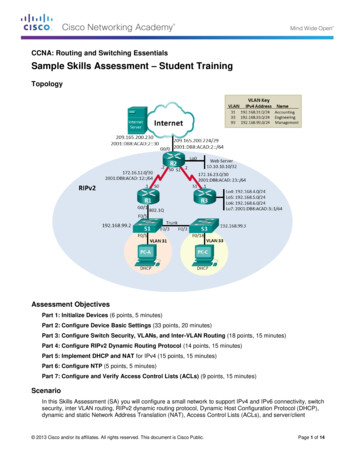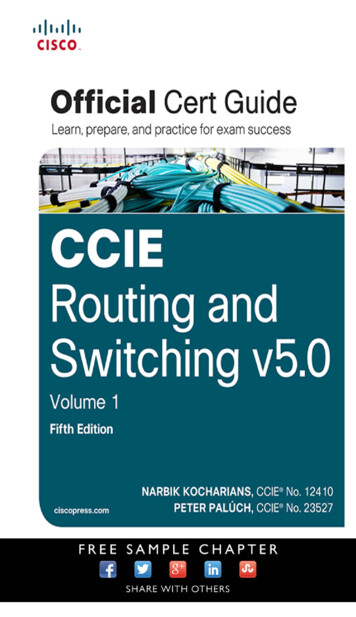
Transcription
CCIE Routing andSwitching v5.0 OfficialCert Guide, Volume 1Fifth EditionNarbik Kocharians, CCIE No. 12410Peter Palúch, CCIE No. 23527Cisco Press800 East 96th StreetIndianapolis, IN 46240
CCIE Routing and Switching v5.0 Official Cert Guide,Volume 1, Fifth EditionNarbik Kocharians, CCIE No. 12410Peter Palúch, CCIE No. 23527Copyright 2015 Pearson Education, Inc.Published by:Cisco Press800 East 96th StreetIndianapolis, IN 46240 USAAll rights reserved. No part of this book may be reproduced or transmitted in any form or by any means,electronic or mechanical, including photocopying, recording, or by any information storage and retrievalsystem, without written permission from the publisher, except for the inclusion of brief quotations in areview.Printed in the United States of AmericaSecond Printing February 2015Library of Congress Control Number: 2014944345ISBN-13: 978-1-58714-396-0ISBN-10: 1-58714-396-8Warning and DisclaimerThis book is designed to provide information about Cisco CCIE Routing and Switching Written Exam,No. 400-101. Every effort has been made to make this book as complete and as accurate as possible, butno warranty or fitness is implied.The information is provided on an “as is” basis. The authors, Cisco Press, and Cisco Systems, Inc. shallhave neither liability nor responsibility to any person or entity with respect to any loss or damages arisingfrom the information contained in this book or from the use of the discs or programs that may accompany it.The opinions expressed in this book belong to the authors and are not necessarily those of CiscoSystems, Inc.
Trademark AcknowledgmentsAll terms mentioned in this book that are known to be trademarks or service marks have been appropriately capitalized. Cisco Press or Cisco Systems, Inc., cannot attest to the accuracy of this information.Use of a term in this book should not be regarded as affecting the validity of any trademark or servicemark.Special SalesFor information about buying this title in bulk quantities, or for special sales opportunities (which mayinclude electronic versions; custom cover designs; and content particular to your business, traininggoals, marketing focus, or branding interests), please contact our corporate sales department atcorpsales@pearsoned.com or (800) 382-3419.For government sales inquiries, please contact governmentsales@pearsoned.com.For questions about sales outside the U.S., please contact international@pearsoned.com.Feedback InformationAt Cisco Press, our goal is to create in-depth technical books of the highest quality and value. Each bookis crafted with care and precision, undergoing rigorous development that involves the unique expertise ofmembers from the professional technical community.Readers’ feedback is a natural continuation of this process. If you have any comments regarding how wecould improve the quality of this book, or otherwise alter it to better suit your needs, you can contact usthrough email at feedback@ciscopress.com. Please make sure to include the book title and ISBN in yourmessage.We greatly appreciate your assistance.Publisher: Paul BogerCopy Editor: John EdwardsAssociate Publisher: Dave DusthimerTechnical Editors: Paul Negron, Sean WilkinsBusiness Operation Manager, Cisco Press:Jan CornelssenEditorial Assistant: Vanessa EvansExecutive Editor: Brett BartowManaging Editor: Sandra SchroederSenior Development Editor:Christopher ClevelandSenior Project Editor: Tonya SimpsonCover Designer: Mark ShirarComposition: Tricia BronkellaIndexer: Tim WrightProofreader: Chuck Hutchinson
ivCCIE Routing and Switching v5.0 Official Cert Guide, Volume 1About the AuthorsNarbik Kocharians, CCIE No. 12410 (Routing and Switching, Security, SP), is a TripleCCIE with more than 32 years of experience in the IT industry. He has designed,implemented, and supported numerous enterprise networks. Narbik is the president ofMicronics Training Inc. (www.micronicstraining.com), where he teaches CCIE R&S andSP boot camps.Peter Palúch, CCIE No. 23527 (Routing and Switching), is an assistant professor, CiscoNetworking Academy instructor, and instructor trainer at the Faculty of ManagementScience and Informatics, University of Zilina, Slovakia. Peter has cooperated in variouseducational activities in Slovakia and abroad, focusing on networking and Linux-basednetwork server systems. He is also active at the Cisco Support Community, holding theCisco Designated VIP award in LAN & WAN Routing and Switching areas since theaward program inception in 2011. Upon invitation by Cisco in 2012, Peter joined two JobTask Analysis groups that assisted defining the upcoming CCIE R&S and CCNP R&S certification exam topics. Peter holds an M.Sc. degree in Applied Informatics and a doctoraldegree in the area of VoIP quality degradation factors. Together with his students, Peterhas started the project of implementing the EIGRP routing protocol into the Quaggaopen-source routing software suite, and has been driving the effort since its inception in2013.
vAbout the Technical ReviewersPaul Negron, CCIE No. 14856, CCSI No. 22752, has been affiliated with networkingtechnologies for 17 years and has been involved with the design of core network services for a number of service providers, such as Comcast, Qwest, British Telecom, andSavvis to name a few. He currently instructs all the CCNP Service Provider–level courses,including Advanced BGP, MPLS, and the QoS course. Paul has six years of experiencewith satellite communications as well as ten years of experience with Cisco platforms.Sean Wilkins is an accomplished networking consultant for SR-W Consulting(www.sr-wconsulting.com) and has been in the field of IT since the mid 1990s, workingwith companies such as Cisco, Lucent, Verizon, and AT&T as well as several other privatecompanies. Sean currently holds certifications with Cisco (CCNP/CCDP), Microsoft(MCSE), and CompTIA (A and Network ). He also has a Master of Science in information technology with a focus in network architecture and design, a Master of Sciencein organizational management, a Master’s Certificate in network security, a Bachelor ofScience in computer networking, and Associates of Applied Science in computer information systems. In addition to working as a consultant, Sean spends most of his time as atechnical writer and editor for various companies; check out this work at his author website: www.infodispersion.com.
viCCIE Routing and Switching v5.0 Official Cert Guide, Volume 1DedicationsFrom Narbik Kocharians:I would like to dedicate this book to my wife, Janet, for her love, encouragement, andcontinuous support, and to my dad for his words of wisdom.From Peter Palúch:To my family, students, colleagues, and friends.
viiAcknowledgmentsFrom Narbik Kocharians:First, I would like to thank God for giving me the opportunity and ability to write, teach,and do what I truly enjoy doing. Also, I would like to thank my family, especially mywife of 29 years, Janet, for her constant encouragement and help. She does such an amazing job of interacting with students and handling all the logistics of organizing classes asI focus on teaching. I also would like to thank my children, Chris, Patrick, Alexandra, andmy little one, Daniel, for their patience.A special thanks goes to Mr. Brett Bartow for his patience and our constant changingof the deadlines. It goes without saying that the technical editors and reviewers did aphenomenal job; thank you very much. Finally, I would like to thank all my students whoinspire me every day, and you, for reading this book.From Peter Palúch:The opportunity to cooperate on the new edition of this book has been an honor andprivilege beyond words for me. Wendell Odom, who has so gracefully and generouslypassed the torch to us, was the key person in introducing me to the Cisco Press representatives as a possible author, and I will be forever indebted to him for all the trust hehas blessed us with. I have strived very much to live up to the unparalelled high level ofcontent all previous authors have maintained throughout all editions of this book, and Iwould like to sincerely thank all of them for authoring such a great book that has significantly helped me achieve my certification in the first place.My next immense thank you goes to Brett Bartow, the executive editor for this book.Brett’s inviting and forthcoming attitude throughout the time of editing the book, compounded with his patience and understanding for my ever-moving (and constantly missed)deadlines, is second to none. He has done all in his power to help us, the authors, withoutcompromising the quality of the work.I would not have been able to complete my work on this volume without the endless support of my family. They have encouraged me, supported me, and gone out of their way toaccommodate my needs. Words are not enough to express my gratitude.Psalm 127, whose musical setting in works of Monteverdi, Handel, or Vivaldi I havecome to admire, begins with words “Unless the Lord build the house, they labor in vainwho build.” Indeed, if it was not first and foremost the Lord’s blessing and help throughout, this work would not have been finished successfully. To my Lord and Savior, JesusChrist—thank you!
viiiCCIE Routing and Switching v5.0 Official Cert Guide, Volume 1Contents at a GlanceIntroductionxxivPart ILAN SwitchingChapter 1Ethernet BasicsChapter 2Virtual LANs and VLAN TrunkingChapter 3Spanning Tree ProtocolPart IIIP NetworkingChapter 4IP AddressingChapter 5IP ServicesPart IIIIP IGP RoutingChapter 6IP Forwarding (Routing)Chapter 7RIPv2 and RIPngChapter 8EIGRP347Chapter 9OSPF453Chapter 10IS-ISChapter 11IGP Route Redistribution, Route Summarization, Default Routing, andTroubleshooting 633Part IVFinal PreparationChapter 12Final PreparationPart VAppendixesAppendix AAnswers to the “Do I Know This Already?” Quizzes 707Appendix BCCIE Exam Updates347103183227267313563701713Index 714CD-OnlyAppendix CDecimal to Binary Conversion TableAppendix DIP Addressing PracticeAppendix EKey Tables for CCIE StudyAppendix FSolutions for Key Tables for CCIE StudyAppendix GStudy PlannerGlossary
ixContentsIntroductionxxivPart ILAN SwitchingChapter 1Ethernet Basics3“Do I Know This Already?” QuizFoundation Topics38Ethernet Layer 1: Wiring, Speed, and DuplexRJ-45 Pinouts and Category 5 WiringAutonegotiation, Speed, and DuplexCSMA/CD88910Collision Domains and Switch BufferingBasic Switch Port ConfigurationEthernet Layer 2: Framing and AddressingTypes of Ethernet AddressesEthernet Address Formats1011141617Protocol Types and the 802.3 Length FieldSwitching and Bridging Logic1819SPAN, RSPAN, and ERSPAN22Core Concepts of SPAN, RSPAN, and ERSPANRestrictions and ConditionsBasic SPAN Configuration2426Complex SPAN ConfigurationRSPAN Configuration26ERSPAN ConfigurationVirtual Switch System262728Virtual Switching System29VSS Active and VSS Standby SwitchVirtual Switch LinkMultichassis EtherChannel (MEC)Basic VSS Configuration31VSS Verification ProceduresIOS-XE38Foundation Summary303041353123
xCCIE Routing and Switching v5.0 Official Cert Guide, Volume 1Memory Builders44Fill In Key Tables from MemoryDefinitions44Further ReadingChapter 24445Virtual LANs and VLAN Trunking“Do I Know This Already?” QuizFoundation TopicsVirtual LANs47475151VLAN Configuration51Using VLAN Database Mode to Create VLANs52Using Configuration Mode to Put Interfaces into VLANsUsing Configuration Mode to Create VLANsModifying the Operational State of VLANsPrivate VLANs565760VLAN Trunking: ISL and 802.1QISL and 802.1Q Concepts6969ISL and 802.1Q Configuration71Allowed, Active, and Pruned VLANs 76Trunk Configuration Compatibility 76Configuring Trunking on Routers802.1Q-in-Q Tunneling79VLAN Trunking Protocol8377VTP Process and Revision NumbersVTP Configuration8689Normal-Range and Extended-Range VLANsStoring VLAN Configuration94Configuring PPPoE 96Foundation SummaryMemory Builders99101Fill In Key Tables from MemoryDefinitions101Further Reading1011019455
xiChapter 3Spanning Tree Protocol103“Do I Know This Already?” QuizFoundation Topics103107802.1D Spanning Tree Protocol and Improvements107Choosing Which Ports Forward: Choosing Root Ports and DesignatedPorts 109Electing a Root Switch110Determining the Root Port111Determining the Designated Port113Converging to a New STP Topology115Topology Change Notification and Updating the CAMTransitioning from Blocking to Forwarding119Per-VLAN Spanning Tree and STP over Trunks119STP Configuration and AnalysisRapid Spanning Tree Protocol124128New Port Roles, States and Types, and New Link TypesChanges to BPDU Format and HandlingProposal/Agreement Process in RSTPTopology Change Handling in RSTPMST Principles of Operation133136137137138Interoperability Between MST and Other STP Versions141144Protecting and Optimizing STPPortFast Ports128132Rapid Per-VLAN Spanning Tree Plus (RPVST )Multiple Spanning Trees: IEEE 802.1sMST Configuration117148148Root Guard, BPDU Guard, and BPDU Filter: Protecting Access PortsProtecting Against Unidirectional Link Issues151Configuring and Troubleshooting EtherChannels154Load Balancing Across Port-Channels154Port-Channel Discovery and ConfigurationTroubleshooting Complex Layer 2 IssuesLayer 2 Troubleshooting Process157161162Layer 2 Protocol Troubleshooting and CommandsTroubleshooting Using Cisco Discovery Protocol163163Troubleshooting Using Link Layer Discovery ProtocolTroubleshooting Using Basic Interface Statistics167165149
xiiCCIE Routing and Switching v5.0 Official Cert Guide, Volume 1Troubleshooting Spanning Tree ProtocolTroubleshooting TrunkingTroubleshooting VTP171172Troubleshooting EtherChannels174Approaches to Resolving Layer 2 IssuesFoundation SummaryMemory Builders179179179Further ReadingPart IIIP NetworkingChapter 4IP Addressing179183“Do I Know This Already?” QuizFoundation TopicsIP Operation175177Fill in Key Tables from MemoryDefinitions170183187187TCP Operation187UDP Operation188IP Addressing and Subnetting188IP Addressing and Subnetting Review188Subnetting a Classful Network NumberComments on Classless Addressing189191Subnetting Math 192Dissecting the Component Parts of an IP Address192Finding Subnet Numbers and Valid Range of IP Addresses—Binary 193Decimal Shortcuts to Find the Subnet Number and Valid Range of IPAddresses 194Determining All Subnets of a Network—Binary196Determining All Subnets of a Network—DecimalVLSM Subnet Allocation198200Route Summarization Concepts201Finding Inclusive Summary Routes—Binary202Finding Inclusive Summary Routes—Decimal203Finding Exclusive Summary Routes—Binary204CIDR, Private Addresses, and NAT 205Classless Interdomain Routing 206Private Addressing 207
xiiiNetwork Address TranslationStatic NAT207209Dynamic NAT Without PAT210Overloading NAT with Port Address TranslationDynamic NAT and PAT ConfigurationIPv6212214IPv6 Address FormatNetwork Prefix215215IPv6 Address Types216Address Management and AssignmentStatic ConfigurationStateful DHCPv6218IPv6 Transition TechnologiesDual Stack218Tunneling219218220Foundation SummaryMemory Builders221225Fill in Key Tables from MemoryDefinitions225225Further ReadingIP Services217217Stateless DHCPTranslation216217Stateless Address AutoconfigurationChapter 5225227“Do I Know This Already?” QuizFoundation Topics227232ARP, Proxy ARP, Reverse ARP, BOOTP, and DHCPARP and Proxy ARP232RARP, BOOTP, and DHCPDHCP236Network Time Protocol240241SNMP Protocol MessagesSNMP MIBs244SNMP SecuritySyslog233234HSRP, VRRP, and GLBPSNMP211245245243232
xivCCIE Routing and Switching v5.0 Official Cert Guide, Volume 1Web Cache Communication Protocol246Implementing the Cisco IOS IP Service Level Agreement (IP SLA)Feature 249Implementing NetFlow250Implementing Router IP Traffic Export252Implementing Cisco IOS Embedded Event ManagerImplementing Remote Monitoring254Implementing and Using FTP on a Router255Implementing a TFTP Server on a Router256Implementing Secure Copy Protocol257Implementing HTTP and HTTPS AccessImplementing Telnet AccessImplementing SSH AccessFoundation SummaryMemory Builders258259264264264Further Reading264Part IIIIP IGP RoutingChapter 6IP Forwarding (Routing)267“Do I Know This Already?” QuizFoundation TopicsIP Forwarding257258Fill In Key Tables from MemoryDefinitions253267271271Process Switching, Fast Switching, and Cisco Express ForwardingLoad Sharing with CEF and Related IssuesMultilayer SwitchingMLS Logic282286286Using Routed Ports and Port-channels with MLSMLS ConfigurationPolicy Routing272287291296Routing Protocol Changes and MigrationPlanning the Migration Strategy299300Activating New IGP While Keeping the Current IGP Intact300Verifying New IGP Adjacencies and Working Database ContentsDeactivating Current IGP301Removing New IGP’s Temporary Settings303Specifics of Distance-Vector Protocols in IGP Migration303301
xvFoundation SummaryMemory Builders309310Fill In Key Tables from MemoryDefinitionsChapter 7Further Reading310RIPv2 and RIPng313“Do I Know This Already?” QuizFoundation Topics313316Introduction to Dynamic RoutingRIPv2 Basics310310316318RIPv2 Convergence and Loop PreventionConverged Steady-State Operation320327Triggered (Flash) Updates and Poisoned Routes328RIPv2 Convergence When Routing Updates CeaseConvergence ExtrasRIPv2 Configuration331334334Enabling RIPv2 and the Effects of AutosummarizationRIPv2 Authentication337RIPv2 Next-Hop Feature and Split HorizonRIPv2 Offset Lists338338Route Filtering with Distribute Lists and Prefix Lists338RIPng for IPv6 339Foundation SummaryMemory BuildersDefinitionsChapter 8EIGRP342345345Further Reading345347“Do I Know This Already?” QuizFoundation Topics335347356EIGRP Basics and Evolution356EIGRP Roots: Interior Gateway Routing ProtocolMoving from IGRP to Enhanced IGRP358EIGRP Metrics, Packets, and Adjacencies360EIGRP Classic Metrics360Bandwidth Metric ComponentDelay Metric Component361361357
xviCCIE Routing and Switching v5.0 Official Cert Guide, Volume 1Reliability Metric Component 362Load Metric Component362MTU Metric Component363Hop Count Metric Component363Calculating the Composite MetricEIGRP Wide Metrics363364Tweaking Interface Metrics to Influence Path SelectionEIGRP Packet FormatEIGRP Packets368368371EIGRP Packets in ActionHello Packets371372Acknowledgment PacketsUpdate Packets372373Query Packet374Reply Packets374SIA-Query and SIA-Reply PacketsReliable Transport ProtocolRouter Adjacencies374376Diffusing Update AlgorithmTopology Table374380380Computed, Reported, and Feasible Distances, and FeasibilityCondition 384Local and Diffusing Computations in EIGRPDUAL FSM397Stuck-In-Active StateEIGRP Named Mode402410Address Family Section414Per-AF-Interface Configuration SectionPer-AF-Topology Configuration SectionAdditional and Advanced EIGRP FeaturesRouter ID417Unequal-Cost Load BalancingAdd-Path SupportStub Routing421423Route SummarizationPassive InterfacesGraceful Shutdown427431432420415416417391
xviiSecuring EIGRP with AuthenticationDefault Routing Using EIGRP432435Split Horizon 436EIGRP Over the ToP437EIGRP Logging and ReportingEIGRP Route FilteringEIGRP Offset Lists443443444Clearing the IP Routing TableFoundation Summary444445Memory Builders 450Fill In Key Tables from MemoryDefinitionsFurther ReadingChapter 9OSPF450450450453“Do I Know This Already?” QuizFoundation Topics460OSPF Database ExchangeOSPF Router IDs453460460Becoming Neighbors, Exchanging Databases, and Becoming AdjacentOSPF Neighbor States462Becoming Neighbors: The Hello Process464Transmitting LSA Headers to Neighbors466Database Description Exchange: Master/Slave RelationshipRequesting, Getting, and Acknowledging LSAsDesignated Routers on LANs466468469Designated Router Optimization on LANsDR Election on LANs470471Designated Routers on WANs and OSPF Network Types472Caveats Regarding OSPF Network Types over NBMA NetworksExample of OSPF Network Types and NBMASPF Calculation479Steady-State Operation480OSPF Design and LSAs480OSPF Design Terms480OSPF Path Selection ProcessLSA Types482482LSA Types 1 and 2461484LSA Type 3 and Inter-Area Costs488474474
xviiiCCIE Routing and Switching v5.0 Official Cert Guide, Volume 1LSA Types 4 and 5, and External Route Types 1 and 2OSPF Design in Light of LSA TypesStubby Areas496496OSPF Path Choices That Do Not Use CostChoosing the Best Type of Path502502Best-Path Side Effects of ABR Loop PreventionOSPF Configuration502505OSPF Costs and Clearing the OSPF Process507Alternatives to the OSPF network CommandOSPF Filtering492510510Filtering Routes Using the distribute-list CommandOSPF ABR LSA Type 3 Filtering511513Filtering Type 3 LSAs with the area range CommandVirtual Link Configuration514515Configuring Classic OSPF Authentication517Configuring Extended Cryptographic OSPF AuthenticationProtecting OSPF Routers with TTL Security CheckTuning OSPF Performance522523Tuning the SPF Scheduling with SPF ThrottlingTuning the LSA Origination with LSA ThrottlingIncremental SPF520524526527OSPFv2 Prefix Suppression 528OSPF Stub Router ConfigurationOSPF Graceful Restart529530OSPF Graceful Shutdown532OSPFv3 533Differences Between OSPFv2 and OSPFv3533Virtual Links, Address Summarization, and Other OSPFv3 FeaturesOSPFv3 LSA Types534OSPFv3 in NBMA Networks536Configuring OSPFv3 over Frame RelayEnabling and Configuring OSPFv3OSPFv3 Authentication and EncryptionOSPFv3 Address Family SupportOSPFv3 Prefix Suppression552OSPFv3 Graceful Shutdown552Foundation Summary553537537548546534
xixMemory Builders 560Fill in Key Tables from Memory 560Definitions 560Further Reading 561Chapter 10IS-IS563“Do I Know This Already?” QuizFoundation Topics563571OSI Network Layer and Addressing572Levels of Routing in OSI Networks576IS-IS Metrics, Levels, and AdjacenciesIS-IS Packet TypesHello Packets577579579Link State PDUs580Complete and Partial Sequence Numbers PDUsIS-IS Operation over Different Network TypesIS-IS Operation over Point-to-Point LinksIS-IS Operation over Broadcast LinksAreas in IS-ISIPv6 Support in IS-ISConfiguring IS-IS587592Memory Builders608610613Foundation Summary625629Fill In Key Tables from Memory630630Further ReadingChapter 11586598Authentication in IS-ISDefinitions585630IGP Route Redistribution, Route Summarization, Default Routing, andTroubleshooting 633“Do I Know This Already?” QuizFoundation Topics633638Route Maps, Prefix Lists, and Administrative Distance638Configuring Route Maps with the route-map Command638Route Map match Commands for Route RedistributionRoute Map set Commands for Route RedistributionIP Prefix Lists641Administrative Distance644640641
xxCCIE Routing and Switching v5.0 Official Cert Guide, Volume 1Route Redistribution 645Mechanics of the redistribute CommandRedistribution Using Default Settings645646Setting Metrics, Metric Types, and Tags649Redistributing a Subset of Routes Using a Route MapMutual Redistribution at Multiple Routers650654Preventing Suboptimal Routes by Setting the AdministrativeDistance 656Preventing Suboptimal Routes by Using Route Tags659Using Metrics and Metric Types to Influence Redistributed RoutesRoute Summarization663EIGRP Route SummarizationOSPF Route SummarizationDefault Routes664665665Using Static Routes to 0.0.0.0, with redistribute staticUsing the default-information originate CommandUsing the ip default-network Command669670Using Route Summarization to Create Default RoutesPerformance Routing (PfR)Performance Routing Concepts673674674Performance Routing Operational RolesMaster Controller (MC)Border Router671672Performance Routing Operational PhasesAuthentication667675675676PfR Basic Configuration677Configuration of the Master ControllerConfiguration of the Border RouterTask Completion on R3677681682Troubleshooting Complex Layer 3 IssuesLayer 3 Troubleshooting Process683684Layer 3 Protocol Troubleshooting and CommandsIP Routing Processes686Approaches to Resolving Layer 3 IssuesFoundation Summary696695686661
xxiMemory Builders698Fill In Key Tables from MemoryDefinitions698698Further ReadingPart IVFinal PreparationChapter 12Final Preparation698701Tools for Final Preparation701Pearson Cert Practice Test Engine and Questions on the CDInstall the Software from the CD701Activate and Download the Practice ExamActivating Other ExamsPremium Edition702703The Cisco Learning NetworkMemory Tables703703Chapter-Ending Review Tools704Suggested Plan for Final Review/StudyUsing the Exam EngineSummary702704704705Part VAppendixesAppendix AAnswers to the “Do I Know This Already?” QuizzesAppendix BCCIE Exam Updates713Index 714CD-OnlyAppendix CDecimal to Binary Conversion TableAppendix DIP Addressing PracticeAppendix EKey Tables for CCIE StudyAppendix FSolutions for Key Tables for CCIE StudyAppendix GStudy PlannerGlossary707701
xxiiCCIE Routing and Switching v5.0 Official Cert Guide, Volume 1Icons Used in This BookCommunicationServerPCPC dquartersTerminalFileServerWebServerCisco WorksWorkstationHouse, RegularPrinterGatewayLaptopRouterLabel SwitchRouterIBMMainframeBridgeClusterControllerATM routerHubCiscoMDS witchProcessorLAN2LANSwitchCiscoMDS 9500OpticalServicesRouterEnterpriseFibre Channel diskFibreChannelJBODONS 15540Network CloudLine: EthernetLine: SerialLine: Switched Serial
xxiiiCommand Syntax ConventionsThe conventions used to present command syntax in this book are the same conventions used in the IOSCommand Reference. The Command Reference describes these conventions as follows: Boldface indicates commands and keywords that are entered literally as shown. Inactual configuration examples and output (not general command syntax), boldfaceindicates commands that are manually input by the user (such as a show command). Italic indicates arguments for which you supply actual values. Vertical bars ( ) separate alternative, mutually exclusive elements. Square brackets ([ ]) indicate an optional element. Braces ({ }) indicate a required choice. Braces within brackets ([{ }]) indicate a required choice within an optional element.
xxivCCIE Routing and Switching v5.0 Official Cert Guide, Volume 1IntroductionThe Cisco Certified Internetwork Expert (CCIE) certification might be the most challenging and prestigious of all networking certifications. It has received numerous awardsand certainly has built a reputation as one of the most difficult certifications to earn inall of the technology world. Having a CCIE certification opens doors professionally andtypically results in higher pay and looks great on a resume.Cisco currently offers several CCIE certifications. This book covers the version 5.0 examblueprint topics of the written exam for the CCIE Routing and Switching certification.The following list details the currently available CCIE certifications at the time of thisbook’s publication; check www.cisco.com/go/ccie for the latest information. The certifications are listed in the order in which they appear on the web page: CCDE CCIE Collaboration CCIE Data Center CCIE Routing & Switching CCIE Security CCIE Service Provider CCIE Service Provider Operations CCIE WirelessEach of the CCDE and CCIE certifications requires the candidate to pass both a writtenexam and a one-day, hands-on lab exam. The written exam is intended to test your knowledge of theory, protocols, and configuration concepts that follow good design practices.The lab exam proves that you can configure and troubleshoot actual gear.Why Should I Take the CCIE Routing and Switching Written Exam?The first and most obvious reason to take the CCIE Routing and Switching written examis that it is the first step toward obtaining the CCIE Routing and Switching certification.Also, you cannot schedule a CCIE lab exam until you pass the corresponding writtenexam. In short, if you want all the professional benefits of a CCIE Routing and Switchingcertification, you start by passing the written exam.The benefits of getting a CCIE certification are varied and include the following: Better pay Career-advancement opportunities
xxv Applies to certain minimum requirements for Cisco Silver and Gold ChannelPartners, as well as those seeking Master Specialization, making you more valuableto Channel Partners Better movement through the problem-resolution process when calling theCisco TAC Prestige Credibility for consultants and customer engineers, including the use of the CiscoCCIE logoThe other big reason to take the CCIE Routing and Switching written exam is that itrecertifies an individual’s associate-, professional-, and expert-level Cisco certifications,regardless of his or her technology track. Recertification requirements do change, soplease verify the requirements at www.cisco.com/go/certifications.CCIE Routing and Switching Written Exam 400-101The CCIE Routing and Switching written exam, at the time of this writing, consists ofa two-hour exam administered at a proctored exam facility affiliated with Pearson VUE(www.vue.com/cisco). The exam typically includes approximately 100 multiple-choicequestions. No simulation questions are currently part of the written exam.As with most exams, everyone wants to know what is on the exam. Cisco provides general guidance as to topics on the exam in the CCIE Routing and Switching written examblueprint, the most recent copy of which can be accessed from www.cisco.com/go/ccie.Cisco changes both the CCIE written and lab blueprints over time, but Cisco seldom, ifever, changes the exam numbers. However, exactly this change occurred when the CCIERouting and Switching blueprint was refreshed for v5.0. The previous written exam forv4.0 was numbered 350-001; the v5.0 written exam is identified by 400-101.Table I-1 lists the CCIE Routing and Switching written exam blueprint 5.0 at press time.Table I-1 also lists the chapters that cover each topic.Table I-1CCIE Routing and Switching Written Exam BlueprintTopicsBookVolumeBookChapter1.1.a (i) Control plane and Forwarding plane111.1.a (ii) Impact on troubleshooting and performance111.1.a (iii) Excluding a specific platform’s architecture1
iv CCIE Routing and Switching v5.0 Official Cert Guide, Volume 1 About the Authors Narbik Kocharians , CCIE No.
